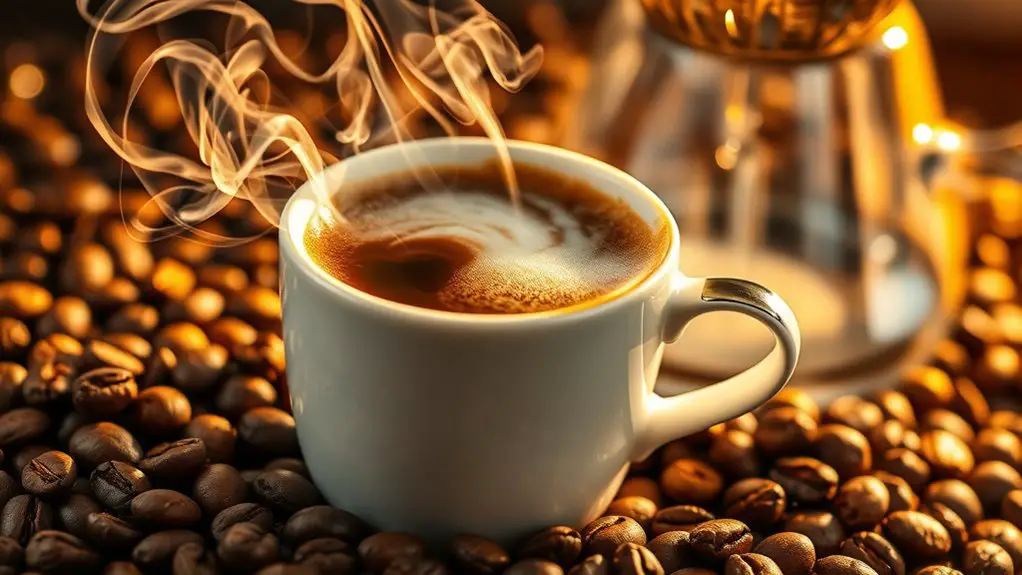The chemistry behind coffee brewing methods hinges on key factors: temperature, brew time, and grind size. Brewing at 195°F to 205°F optimizes flavor extraction, while extended brew times can increase strength but risk bitterness. Grind size affects extraction efficiency, with coarse grinds yielding weak flavors, and fine grinds leading to over-extraction. Each method, such as espresso's rapid extraction versus pour-over's control, creates distinct taste profiles. Explore how these elements interact to enhance your coffee experience even further.
The Role of Temperature in Flavor Extraction
When you brew coffee, the temperature of the water plays an essential role in flavor extraction. The ideal temperature ranges for brewing typically fall between 195°F and 205°F. Within this range, you'll find that various compounds within the coffee grounds dissolve effectively, affecting the overall flavor profiles. If the water's too hot, it can lead to over-extraction, resulting in bitter notes that overshadow more delicate flavors. Conversely, water that's too cool may under-extract, leaving you with a weak and sour cup. Understanding these temperature dynamics allows you to manipulate the brewing process, enhancing your coffee experience. Each temperature range not only alters extraction rates but also shapes the complexity of flavors you can enjoy in your cup.
Impact of Brew Time on Coffee Strength
Although many factors influence coffee strength, brew time is one of the most important. The duration you allow water to interact with coffee grounds directly affects extraction. Longer brew times typically increase the concentration of soluble compounds, enhancing flavor and strength. However, it's essential to find a balance; overly prolonged extraction can lead to bitterness and undesirable flavors.
For example, a French press may require a four-minute brew time for ideal strength, while a pour-over might only need three minutes. By adjusting your brew time, you control the coffee's strength and overall taste profile. Experimenting within these parameters allows you to tailor your coffee experience, granting you the freedom to discover your perfect cup. Additionally, using ground coffee in your brewing process can significantly enhance the overall flavor experience.
The Importance of Grind Size
While many elements contribute to the brewing process, grind size plays a significant role in determining the extraction efficiency of coffee. The consistency of your grind directly affects how water interacts with the coffee particles. For example, a coarse grind exposes less surface area, resulting in weaker extraction, while a fine grind may lead to over-extraction, yielding bitterness. Achieving grind consistency is essential; uneven particles can cause variable extraction rates, diminishing your brew's flavor profile. By controlling grind size, you guarantee that water extracts flavors evenly, enhancing aroma and taste. Whether you prefer a robust or subtle cup, understanding the importance of grind size empowers you to tailor your coffee experience, allowing for freedom in flavor exploration. Setting the grind size to position 5 is recommended for balanced extraction without bitterness.
Comparing Brewing Techniques: Espresso vs. Pour-Over
Espresso and pour-over are two distinct brewing techniques that showcase the versatility of coffee preparation, each offering unique flavors and experiences. With espresso extraction, you're looking at a rapid process that pressures hot water through finely-ground coffee, creating a concentrated shot with intense flavors. This method emphasizes boldness and richness, perfect for those who enjoy a strong coffee experience. On the other hand, pour-over precision allows for greater control over brewing variables such as water temperature and pour rate. This technique often highlights subtle flavor notes and a cleaner profile, appealing to those who appreciate complexity in their cup. Ultimately, your choice between espresso and pour-over hinges on your taste preferences and how you want to experience coffee's diverse nuances. Understanding espresso bitterness can further enhance your appreciation of these brewing methods.
The Chemistry of Cold Brew: A Unique Process
When you explore the chemistry of cold brew, you'll discover a fascinating interplay of time and temperature that sets it apart from traditional brewing methods. Cold extraction employs a longer steeping time, often 12-24 hours, using room temperature or cold water. This process enhances specific flavor compounds while minimizing acidity.
Discover the unique chemistry of cold brew, where time and temperature create a smoother, less acidic coffee experience.
Key elements of cold brew chemistry include:
- Flavor extraction: Delicate compounds are drawn out, resulting in a smoother profile.
- Reduced bitterness: Lower temperatures limit the extraction of harsh flavors.
- Caffeine content: Cold brew can yield a higher caffeine concentration due to the prolonged contact with coffee grounds.
- Versatility: The concentrate can be customized with milk or sweeteners, offering freedom in flavor exploration.
Frequently Asked Questions
What Types of Coffee Beans Are Best for Brewing?
When it comes to coffee beans, you've got to know your options. Arabica beans offer sweetness and complexity, while Robusta beans pack a punch with boldness. Choose based on your flavor preferences and brewing style.
How Does Water Quality Affect Coffee Taste?
Water quality considerably impacts coffee taste. Hardness and mineral content influence extraction efficiency, altering flavor profiles. Balanced minerals enhance sweetness, while excessive hardness can lead to bitterness, ultimately affecting your overall coffee experience.
Can I Reuse Coffee Grounds for Brewing?
Imagine trying to squeeze flavor from a wet sponge. Coffee ground reuse can yield some flavor extraction, but it's limited. For ideal taste, fresh grounds are usually best, allowing you the freedom to enjoy coffee's full potential.
What Is the Ideal Coffee-To-Water Ratio?
For ideal flavor, aim for a coffee-to-water ratio of 1:15. Verify your brewing temperature is around 195°F and maintain an extraction time of 4-5 minutes, enhancing the coffee's richness and complexity without bitterness.
Does the Brewing Method Affect Caffeine Content?
Doesn't it make sense that brewing variables impact caffeine extraction? Different methods, like espresso or cold brew, extract caffeine differently, influencing your cup's potency. Understanding this can enhance your coffee experience and satisfy your taste for freedom.
